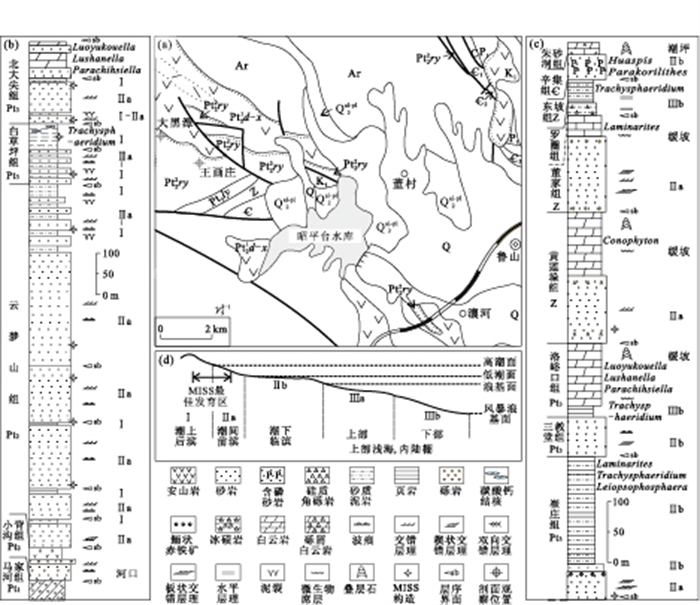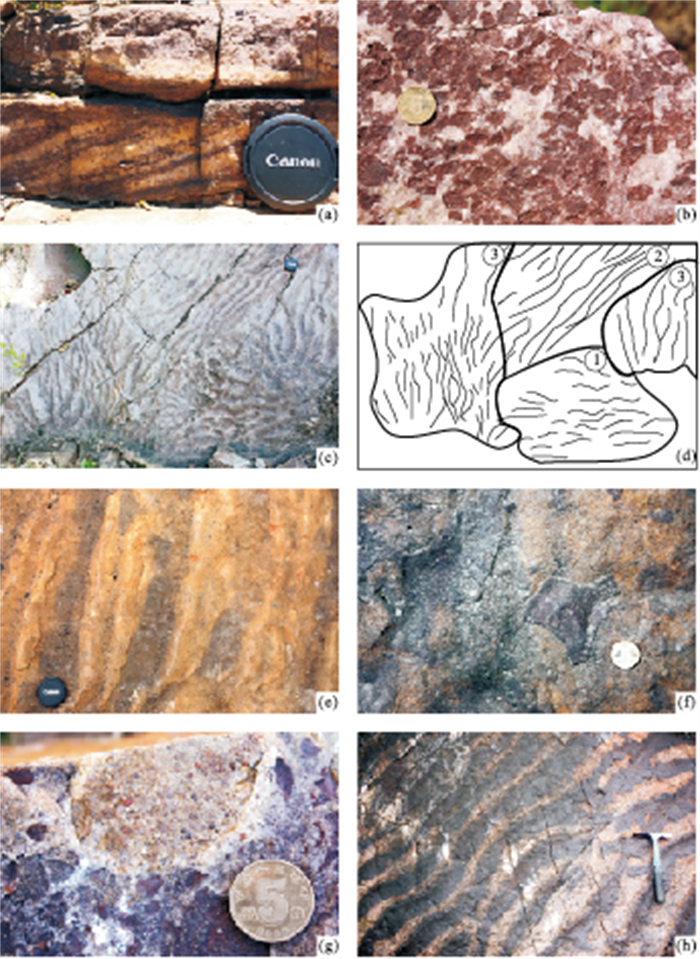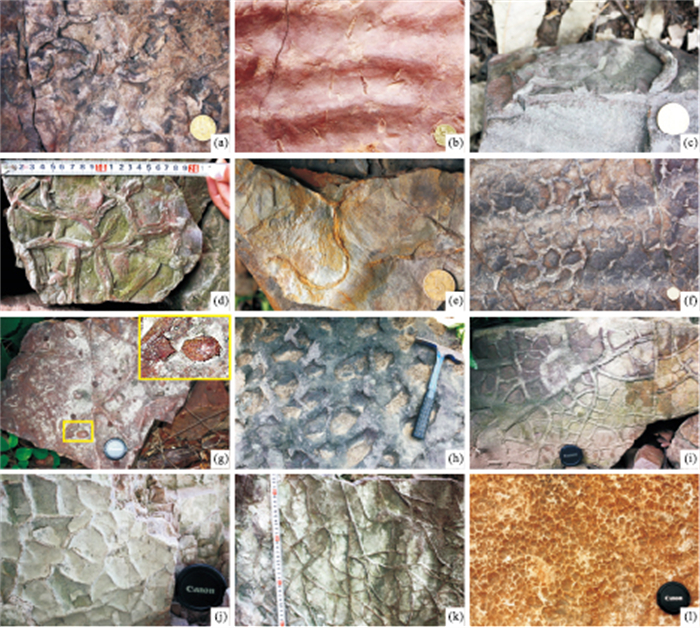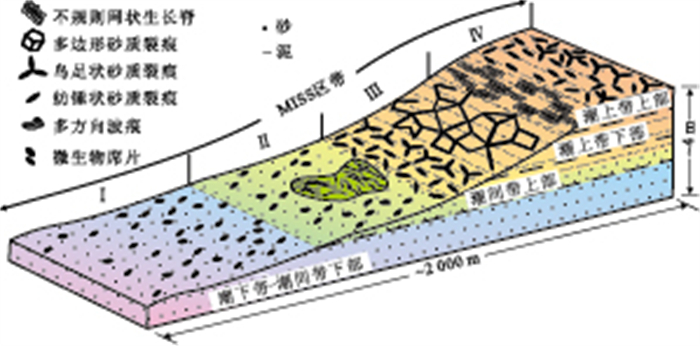Morphologic Association of Microbially Induced Sedimentary Structures As Paleoenvironment Indicator: An Example from Meso- to Neo-Proterozoic Siliciclastics of Southern North China Platform
-
摘要: 微生物席成因构造(microbially induced sedimentary structures, MISS)是由微生物与沉积物相互作用形成的生物-沉积构造, 可作为早期微生物群活动的重要标识, 但对其指示古环境的研究尚显不足.华北地台南部中-新元古代汝阳群(Pt2)和洛峪群(Pt3)以近岸浅水陆源碎屑沉积为主, 其中发育大量MISS, 包括多向波痕、微生物席稳化波痕、微生物席碎片、微生物席平滑波痕、多种微生物席脱水形成的砂裂及不规则网状生长脊等.研究表明, 在潮坪环境中MISS最为发育.地势差异对水动力、基底暴露、水分补给和沉积条件等环境因素具有显著控制作用, 影响微生物席的发育与结构, 因此, MISS的形态组合特征能够反映沉积微相变化.研究发现, 在潮上带以微生物席脱水形成的砂裂构造为主, 潮间带上部以破坏-改造型构造为主, 潮间带下部-潮下带一般少见原位MISS, 但可见再沉积微生物席碎片.据潮间带下部至潮上带上部MISS产出类型及其形态组合分析, 识别了4个MISS形态组合带, MISS形态组合由潮间带下部至潮上带上部的变化反映了古地形由低到高的明显变化.Abstract: Microbially induced sedimentary structures (MISS) are derived from the interaction of microbes and sedimentation by various geological processes, and have been studied more often as biosignature for early life, while their significance in paleoenvironmental analysis has not been adequately studied yet. Our study shows that the Ruyang (Pt2) and Luoyu Groups (Pt3) in the southern North China Platform are dominated by peritidal silisiclastics with abundant MISS, especially those related with mat destruction, and indicates that the morphologic variation and association of MISS are largely influenced by topography. The topography, to some extent, determines the hydrodynamics, substrate exposure duration and water supplement, and exerts influence on mat growth and their destruction, and in turn influence the morphology of MISS, especially in peritidal environments. From the subtidal to supratidal, four zones have been recognized, each of them with its own distinctiveness in MISS morphological association. The subtidal to lower intertidal zone is short of in situ MISS but has some redeposited mat chips, while the upper intertidal is featured by mat protected ripple marks and chips. The lower supertidal is rich in various MISS, especially sand cracks, for its low hydrodynamics, sufficient water supplement and frequently exposed environment, with thick mats, while the upper supertidal abounds smaller sand cracks than those in lower supertidal zone due to relatively thin microbial mats. Thus, Meso- to Neo-proterozoic MISS from the southern North China Platform show that the morphologic association of MISS can be used as good indicators for paleoenvironmental reconstruction.
-
图 2 豫西鲁山中新元古界潮下带-潮上带下部MISS形态特征
a.云梦山组潮下带-潮间带下部中粗粒石英砂岩,发育板状交错层理,微生物席碎片顺层理面散布;b.云梦山组潮下带-潮间带下部交错层理面上的微生物席碎片;c.北大尖组潮间带上部砂岩层面上的多向波痕;d.照片C中多向波痕示意图,图中数字表示该波痕斑块的形成期次,其中1期波痕占总面积的20%,2期波痕占22%,3期波痕占37%,未被占据的面积约21%(形成越早的波痕保留的部分越少,每期斑块内的波痕方向一致);e.云梦山组潮间带上部砂岩层面上的微生物席保护波痕,在波痕表面覆有微生物席层成因的砂薄片;f.云梦山组潮间带上部砂岩层面上残留的席片;g.云梦山组潮间带下部粗砂岩层面上残留的砂砾斑块;h.云梦山组潮上带下部细砂岩层面上被微生物席平滑的波痕;图中镜头盖直径5.5cm,硬币直径2cm,地质锤长度32cm
Fig. 2. Photographs showing morphology of the MISS from subtidal to lower supertidal in Meso- to Neo-proterozic, Lushan, western Henan
图 3 豫西鲁山中新元古界潮上带MISS形态特征
a.北大尖组纺锤状砂裂;b.云梦山组与波痕伴生的纺锤状砂裂;c.北大尖组纺锤状砂裂在断面上的形态;d.北大尖组相互叠加的鸟足状砂裂;e.北大尖组曲形砂裂;f.云梦山组与波痕伴生的网状砂裂;g.云梦山组与石盐假晶共生的网状砂裂,图中右上角照片为左下角方框部位的放大图,显示了两种不同晶型的石盐假晶;h.云梦山组砂脊粗大的网状砂裂;i.云梦山组具多级分支的叶脉状砂裂;j.白草坪组中的纺锤状砂裂(底面);k.白草坪组中的树枝状砂砂裂(底面);l.云梦山泥质细砂岩组砂岩层面上的网状生长脊;图中镜头盖直径5.5cm,硬币直径2cm,地质锤长度32cm
Fig. 3. Photographs showing morphology of the MISS from supertidal in Meso- to Neo-proterozic, Lushan, western Henan
-
Banerjee, S., Jeevankumar, S., 2005. Microbially originated wrinkle structures on sandstone and their stratigraphic context: palaeoproterozoic Koldaha Shale, Central India. Sedimentary Geology, 176(1-2): 211-224. doi: 10.1016/j.sedgeo.2004.12.013 Bose, S., Chafetz, H.S., 2009. Topographic control on distribution of modern microbially induced sedimentary structures (MISS): a case study from Texas coast. Sedimentary Geology, 213(3-4): 136-149. doi: 10.1016/j.sedgeo.2008.11.009 Bouougri, E.H., Porada, H., 2007. Siliciclastic biolaminites indicative of widespread microbial mats in the Neoproterozoic Nama Group of Namibia. Journal of African Earth Sciences, 48(1): 38-48. doi: 10.1016/j.jafrearsci.2007.03.004 Eriksson, P.G., Schieber, J., Bouougri, E., et al., 2007. Classification of structures left by microbial mats in their host sediments. In: Schieber, J., Bose, P.K., Eriksson, P.G., et al., eds., Atlas of microbial mat features preserved within the clastic rock record. Elsevier, Amsterdam, 39-52. Eriksson, P.G., Simpson, E.L., Eriksson, K.A., et al., 2000. Muddy roll-up structures in siliciclastic interdune beds of the c. 1.8Ga Waterberg Group, South Africa. Palaios, 15(3): 177-183. doi:10.1669/0883-1351(2000)015<0177:MRUSIS>2.0.CO Gerdes, G., 2007. Structures left by modern microbial mats in their host sediment's. In: Schieber, J., Bose, P.K., Eriksson, P.G., et al., eds., Atlas of microbial mat features preserved within the clastic rock record. Elsevier, Amsterdam, 5-38. Gerdes, G., Klenke, T., Noffke, N., 2000. Microbial signatures in peritidal siliciclastic sediments: a catalogue. Sedimentology, 47(2): 279-308. doi: 10.1046/j.1365-3091.2000.00284.x Gerdes, G., Krumbein, W.E., Reineck, H.E., 1985. The depositional record of sandy, versicolored tidal flats Mellum Island, southern North Sea. Journal of Sedimentary Research, 55(2): 265-278. doi: 10.1306/212F8698-2B24-11D7-8648000102C1865D Hardie, L.A., 1977. Sedimentation on the modern carbonate tidal flats of northwest Andros Island, Bahamas. Johns Hopkins University Press, Maryland. Lu, S.N., Zhao, G.C., Wang, H.C., et al., 2008. Precambrian metamorphic basement and sedimentary cover of the North China craton: a review. Precambrian Research, 160(1-2): 77-93. doi: 10.1016/j.precamres.2007.04.017 Mei, M.X., Meng, Q.F., Gao, J.H., 2007. Microbial sand chips in transgressive sandstones of the Precambrian: an example from the Dahongyu Formation at the Huyu section of the Nankou Town in Beijing. Earth Science Frontiers, 14(2): 197-204 (in Chinese with English abstract). doi: 10.1016/S1872-5791(07)60017-7 Noffke, N., 1998. Multidirected ripple marks rising from biological and sedimentological processes in modern lower supratidal deposits (Mellum Island, southern North Sea). Geology, 26(10): 879-882. doi:10.1130/0091-7613(1998)026<0879:MRMRFB>2.3.CO;2 Noffke, N., 2005. Geobiology—a holistic scientific discipline. Palaeogeography, Palaeoclimatology, Palaeoecology, 219(1-2): 1-3. doi: 10.1016/j.palaeo.2004.10.010 Noffke, N., Beukes, N., Bower, D., et al., 2008. An actualistic perspective into Archean worlds—(cyano-) bacterially induced sedimentary structures in the siliciclastic Nhlazatse Section, 2.9 Ga Pongola Supergroup, South Africa. Geobiology, 6(1): 5-20. doi: 10.1111/j.1472-4669.2007.00118.x Noffke, N., Beukes, N., Gutzmer, J., et al., 2006a. Spatial and temporal distribution of microbially induced sedimentary structures: a case study from siliciclastic storm deposits of the 2.9 Ga Witwatersrand Supergroup, South Africa. Precambrian Research, 146(1-2): 35-44. doi: 10.1016/j.precamres.2006.01.003 Noffke, N., Eriksson, K.A., Hazen, R.M., et al., 2006b. A new window into Early Archean life: microbial mats in Earth's oldest siliciclastic tidal deposits (3.2 Ga Moodies Group, South Africa). Geology, 34(4): 253-256. doi: 10.1130/G22246.1 Noffke, N., Gerdes, G., Klenke, T., 2003. Bethic cyanobacteria and their influence on the sedimentary dynamics of peritidal depositional systems (siliciclastic, evaporitic salty, and evaporitic carbonatic). Earth Science Review, 62(1-2): 163-176. doi: 10.1016/S0012-8252(02)00158-7 Noffke, N., Gerdes, G., Klenke, T., et al., 2001a. Microbially induced sedimentary structures: a new category within the classification of primary sedimentary structures. Journal of Sedimentary Research, 71(5): 649-656. doi: 10.1306/2DC4095D-0E47-11D7-8643000102C1865D Noffke, N., Gerdes, G., Klenke, T., et al., 2001b. Microbially induced sedimentary structures indicating climatological, hydrological and depositional conditions within recent and Pleistocene coastal facies zones (southern Tunisia). Facies, 44(1): 23-30. doi: 10.1007/BF02668164 Noffke, N., Krumbein, W.E., 1999. A quantitative approach to sedimentary surface structures contoured by the interplay of microbial colonization and physical dynamics. Sedimentology, 46(3): 417-426. doi: 10.1046/j.1365-3091.1999.00218.x Pflüger, F., Gresse, P.G., 1996. Microbial sand chips—a non-actualistic sedimentary structure. Sedimentary Geology, 102(3-4): 263-274. doi: 10.1016/0037-0738(95)00072-0 Porada, H., Bouougri, H.E., 2007. Wrinkle structures—a critical review. Earth Science Reviews, 81(3-4): 199-215. doi: 10.1016/j.earscirev.2006.12.001 Prave, A.R., 2002. Life on land in the Proterozoic: evidence from the Torridonian rocks of Northwest Scotland. Geology, 30(9): 811-814. doi:10.1130/0091-7613(2002)030<0811:LOLITP>2.0.CO;2 Qi, Y.A. 2005. Trace fossils from Yumengshan Formation (Ruyang Group) of Lushan Country, Henan Province. Journal of Henan Polytechnic University, 24(1): 33-37 (in Chinese with English absract). http://www.researchgate.net/publication/313191402_Trace_fossils_from_Yumengshan_Formation_Ruyang_Group_of_Lushan_Country_Henan_Province Sarkar, S., Banerjee, S., Samanta, P., et al., 2006. Microbial mat-induced sedimentary structures in siliciclastic sediments: examples from the 1.6 Ga Chorhat sandstone, Vindhyan supergroup, M, P., India. Journal of Earth System Science, 115(1): 49-60. doi: 10.1007/BF02703025 Sarkar, S., Bose, P.K., Samanta, P., et al., 2008. Microbial mat mediated structures in the Ediacaran Sonia Sandstone, Rajasthan, India, and their implications for Proterozoic sedimentation. Precambrian Research, 162(1-2): 248-263. doi: 10.1016/j.precamres.2007.07.019 Schieber, J., 1998. Possible indicators of microbial mat deposits in shales and sandstones: examples from the Mid-Proterozoic belt Supergroup, Montana, USA. Sedimentary Geology, 120(1-4): 105-124. doi: 10.1016/S0037-0738(98)00029-3 Schieber, J., 2004. Microbial mats in the siliciclastic Rock record: a summary of diagnostic features. In: eriksson, P.G., Altermann, W., Nelson, D.R., et al., eds., The Precambrian earth: tempos and events. Developments in Precambrian Geology, 12. Elsevier, Netherlands, 663-673. Schieber, J., Bose, P.K., Eriksson, P.G., et al., 2007. Atlas of microbial mat features preserved within the siliciclastic rock record. Elsevier, Netherlands. Shi, X.Y., Chen, C.Q., 2006. Microbially induced sedimentary structures (MISS) from the Changcheng Group (ca 1.6 Ga), North China Platform, and their implications for an oxygen-defficient shallow sea environment. In: Yang, Q., Wang, Y., Weldon, E.A., eds., Ancient life and mordern approaches. China University of Science and Technology Press, Hefei, 188-189. Shi, X.Y., Wang, X.Q., Jiang, G.Q., et al., 2008. Pervassive microbial mat colonization on Mesoproterozoic peritidal siliciclastic substrates: an example from the Huangqikou Formation (ca 1.6 Ga) in Helan Mountains, NW China. Geological Review, 54(5): 577-586 (in Chinese with English abstract). http://en.cnki.com.cn/Article_en/CJFDTOTAL-DZLP200805003.htm Wang, H.Z., Shi, X.Y., Wang, X.L., et al., 2000. Research on the sequence stratigraphy of China. Guangdong Science and Technology Press, Guangzhou (in Chinese). Yang, S.F., Zhou, H.R., 1995. Trace fossils from the Precambrian Ruyang Group of western Henan. Geological Review, 41(3): 205-210 (in Chinese with English abstract). http://en.cnki.com.cn/Article_en/CJFDTOTAL-DZLP199503001.htm Zhou, H.R., Wang, Z.Q., Cui, X.S., 1998. Study on sedimentology and sequence stratigraphy of the Mesoproterozoic and Neoproterozoic in the west of Henan Province. Geoscince, 12(1): 17-24 (in Chinese with English abstract). http://qikan.cqvip.com/Qikan/Article/Detail?id=3014137 梅冥相, 孟庆芬, 高金汉, 2007. 前寒武纪海侵砂岩中的微生物砂质碎片: 以北京南口虎峪剖面大红峪组为例. 地学前缘, 14(2): 197-204. doi: 10.3321/j.issn:1005-2321.2007.02.016 齐永安, 2005. 河南鲁山汝阳群云梦山组遗迹化石. 河南理工大学学报, 24(1): 33-37. https://www.cnki.com.cn/Article/CJFDTOTAL-JGXB200501009.htm 史晓颖, 王新强, 蒋干清, 等, 2008. 贺兰山地区中元古代微生物席成因构造——元古时期微生物群活动的沉积标志. 地质论评, 54(5): 577-586. doi: 10.3321/j.issn:0371-5736.2008.05.001 王鸿祯, 史晓颖, 王训练, 等, 2000. 中国层序地层研究. 广州: 广东科技出版社. 杨式溥, 周洪瑞, 1995. 豫西前寒武纪汝阳群遗迹化石. 地质论评, 41(3): 205-210. doi: 10.3321/j.issn:0371-5736.1995.03.002 周洪瑞, 王自强, 崔新省, 1998. 豫西地区中、新元古代地层沉积特征及层序地层学研究. 现代地质, 12(1): 17-24. https://www.cnki.com.cn/Article/CJFDTOTAL-XDDZ801.001.htm -










 下载:
下载:




